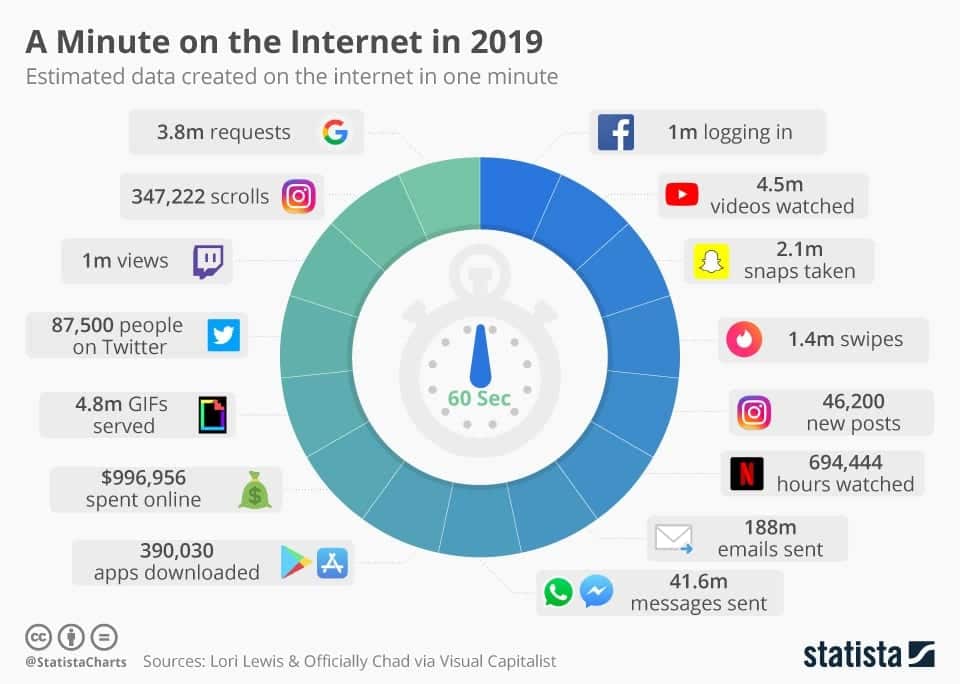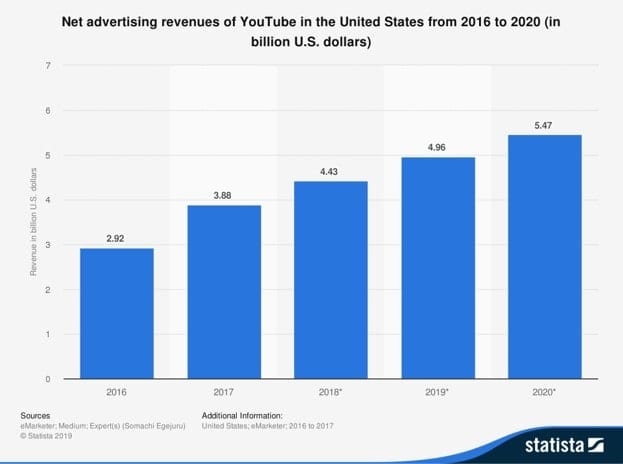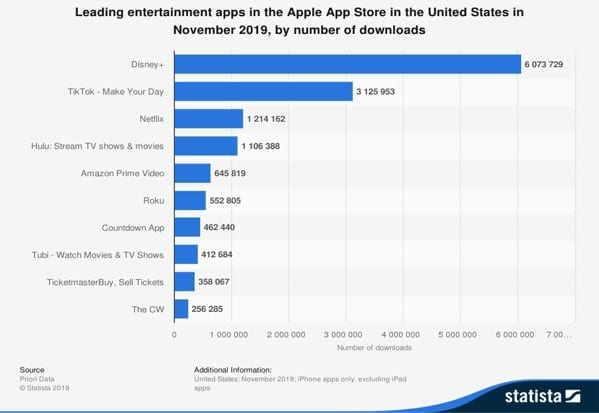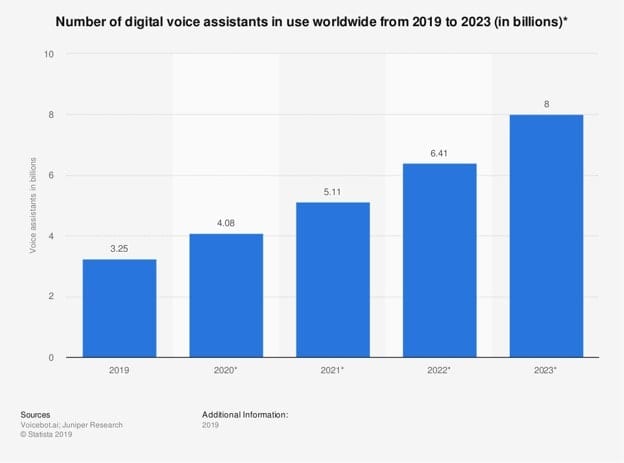The landscape of digital marketing is constantly changing. As technology continues to advance by the year, it’s crucial that your digital marketing strategy advances with it. Being aware of current trends will keep customers interested in your content and services. Staying relevant is key when it comes to digital marketing. Read on for some trends that are expected to explode in reach and popularity as we move into the next decade.
Video
Augmented Reality (AR)
Artificial Intelligence (AI)
Personalization
Visual Search
Conclusion
Video
Video is rapidly becoming one of the main forms of media people are using the internet to access. According to the chart below, in 2019, an average of 4.5 million videos were watched per minute on YouTube alone. Furthermore, Zenith predicts that people will spend an average of 100 minutes per day watching online videos by 2021.
So how can you use video as part of your digital marketing strategy?
Social media stories
Some of the most popular apps in the world – Instagram, Snapchat, and Facebook – enable users to post “stories” to their accounts. A story is a photo or short video that is only available for 24 hours. It offers your users a personal connection to your business and is a great opportunity to get creative and build your brand’s image. Other benefits of posting stories on your social channels are:
- Engagement with followers
- Increased brand awareness
- Cost-effectiveness (they’re free to post)
- Social reach
Posting promotions or flash sales to your social media stories will encourage customers to continue checking your page. This is a great way to reach a younger demographic, as 61% of people between 18 and 24 use Snapchat stories, and 52% use Instagram stories.
YouTube
Commonly considered the go-to video app, YouTube is a major source of entertainment and educational content. People turn to YouTube when they have a question about a product or want to see it used or demonstrated. As illustrated by the chart below, YouTube is projected to hit $5.5 billion in ad revenue sales. That’s reflective of a steady incline over the past few years.
Creating a YouTube channel with engaging videos on your products or services will make your business more approachable. Users can subscribe to your company’s YouTube channel and even sign up for notifications of when you post a video. Encouraging them to leave comments under your videos is a great way to engage with your customers and receive valuable feedback.
TikTok
One of the fastest-growing social media platforms worldwide, TikTok allows users to post their own short-form video content. As of 2019, the app had:
- 5 billion downloads
- 500 million active users (ahead of Twitter and Snapchat)
- 188 million new users per year
According to the above graph, TikTok was the Apple App Store’s second most-downloaded app of 2019. 41% of TikTok’s users are between the ages of 16 and 24, so if this is your target audience, making short-form videos for a TikTok account could be a great idea for your business. Like YouTube, users can follow your feed and interact with you and each other in the comments. TikTok is expected to continue to lead amongst social networking apps in 2020.
Click here for more on identifying your target audience.
Live-streaming
Some of the most popular social media platforms – Instagram and Facebook – offer users the ability to create live videos. Streaming accounts for over two-thirds of all internet traffic, and is expected to jump to 82% in 2020. In addition, the streaming industry is estimated to reach $70.05 billion by 2021. Streaming also allows subscribers to view and engage with your business in real time. This is a way for you to interact with your customers, answers questions, and develop authenticity for your brand.
Augmented Reality (AR)
Augmented reality is an emerging sales technology. It allows customers to “try” a product, virtually, before buying it. For example, a company that sells sunglasses could use AR to let people see how their glasses would look on them through the use of their smartphone camera. This technology is still in development, but is quickly becoming popular amongst businesses that sell clothing, cosmetics, accessories, and furniture, just to name a few. Amazon recently began using AR to allow users to place a piece of furniture in their room to see how it will look in the space. StubHub now allows customers to see the view from seats before purchasing.
AR can also be used to:
- Allow customers to scan a ticket, business card, brochure, or coupon, and instantly access your information on their phones
- Display 3D views of your products on your website
- Create a tour of your store or office
AR allows for a unique, interactive experience that will make your brand memorable.
Zero-Click Search
No click searches display a concise answer to a user’s question at the top of Google’s search engine result page (SERP). These featured bites of information streamline the process and make answers to queries quick and accessible. In fact, 34% of desktop searches 62.5% of mobile searches are now zero-click.
So, how can you make sure your company’s information is delivered through a no-click search? While it’s impossible to ensure Google’s algorithm will feature your snippet, creating precise question-and-answer content increases your chances. Using the most-searched keywords in your industry throughout your content, without overdoing it, can certainly help.
Artificial Intelligence (AI)
Content generation
AI programs like Wordsmith, Heliograf, and Quill, are being used to automatically create content for online publications such as the Washington Post, the New York Times, and Forbes. While this technology is still in its early stages, it is likely to continue to grow in popularity through the next decade. Furthermore, according to Joe Pulizzi, founder of the Content Marketing Institute, “In 10 years the majority of content will be generated by software.” AI has the potential to streamline the process of creating content that can be used to keep your social channels active with news and updates on your business.
Chatbots
Chatbots are programs that simulate conversations with users. People across the globe are spending a lot of time messaging one another via social messaging apps. You want your business to be where the people are – especially if your target demographic is on the younger side. For example, 27.3% of Facebook Messenger’s users and 29% of WhatsApp users in the United States are between the ages of 25 and 34. These messaging apps could be a good way to get your products in front of your customers if this is the age range you’re targeting.
In addition, 80% of businesses are projected to integrate a chatbot system in 2020. If a customer has a question about your products, they want an instant answer. Chatbots are often designed to:
- Offer product details
- Answer basic questions
- Complete purchases
- Initiate refund requests
- Provide customer support
- Collect customer contact information
By providing instant answers and support, chatbots encourage your customers to purchase from you. They can also save your business support costs by taking the place of an actual 24/7 representative. Learn more about Facebook Messenger’s chatbot.
Voice Search
Amazon Alexa and Echo, as well as Google Home, Apple Siri, and Microsoft Cortana, are examples of extremely popular voice search assistants. As the chart below illustrates, voice technology is expected to grow consistently into the next decade.
With 4.08 billion voice assistants in use worldwide as of 2020, this technology is revolutionizing the way people search for products and services. In fact, voice-based shopping is expected to jump to $40 billion in 2022.
According to a 2019 study, the most common voice searches conducted included:
- 54% restaurant reservations
- 46% inquiries about prices of products from local businesses
- 40% inquiries regarding whether a certain product is available at a business
When people make a voice search, they will likely be speaking in a conversational tone. They are also likely to phrase their search as a question. You will need to adapt your digital marketing strategy to make sure your business can be found through voice search. You can do that by:
- Using more natural-sounding language in your content
- Optimizing your featured snippets
- Developing lots of authoritative as well as informative content across platforms
- Providing concise answers to questions, like business hours
- Using long-tail (extra-specific) keywords
- Making sure your website is mobile-friendly
Personalization
Consumers are becoming increasingly annoyed with generic, spam-like advertising. Additionally, according to an Epsilon study, 80% of people say they are more likely to do business with a company if it offers a personalized experience. Netflix and Hulu, for example, recommend movies and shows to users based on things they’ve watched previously.
So, how do you personalize advertisements? After all, your ads are going to be seen by thousands of different people. Personalizing your material to each and every one would be impossible. Here’s what you can do:
- Use purchase history to advertise similar products and anticipate future needs
- Offer surveys and questionnaires asking customers for opinions on your products and what they’d like to see from your business
- Use e-mail and mobile notifications to reach out to your customers about products they’ve expressed interest in
Personalized ads can help consumers find the things they’re actually interested in quickly and easily. Similarly, multiple forms of AI, like chatbots, can be used to send your customers product information that’s relevant to them. Make sure you don’t overdo it, however – some consumers find over-personalized advertising a little intrusive.
Visual Search
Let’s say you come across a photo of a pair of shoes that you want to buy. There’s no information in the picture, however, about the brand, or where you can find them. Fortunately, you can drag and drop the image into a visual search engine and instantly find the shoes you’re looking for, as well as similar ones.
People are searching for products via images more and more often. In fact, the image recognition market reached $25.65 billion in 2019. In addition, Pinterest, an image-based search app, is projected to hit $1 billion a year in ad revenue in the coming decade.
You can implement image search visibility into your digital marketing strategy by doing the following:
- Use image search in your website’s inventory
- Advertise on image-based apps, such as Instagram and Pinterest
- Use SEO in the metadata of the images on your site
Visual search is yet another way technology has made finding information instant.
In Conclusion
The next decade is sure to be full of major strides in technology. That certainly doesn’t mean your business will be left behind. Embracing technology will help you connect with your target audience and build your brand. Consider these tips for staying modern and relevant moving into the future.






